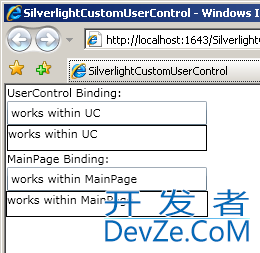Silverlight UserControl Custom Property Binding
What is the proper way to implement Custom Properties in Silverlight UserControls?
Every "Page" in Silverlight is technically a UserControl (they are derived from the UserControl class). When I say UserControl here, I mean a Custom UserControl that will be used inside many different pages in many different scenarios (similar to an ASP.NET UserControl).
I would like the Custom UserControl to support Binding and not rely on the Name of the Property it is binding to, to always be the same. Instead, I would like the UserControl itself to have a property that the Controls inside the UserControl bind to, and the ViewModels outside the UserControl also bind to. (please see the example below)
Binding within the UserControl works, Binding within the MainPage works, The Binding I set up between the MainPage and the UserControl does not work. Specifically this line:
<myUserControls:MyCustomUserControl x:Name="MyCustomControl2"
SelectedText="{Binding MainPageSelectedText, Mode=TwoWay}"
Width="200" Height="50" />
example output:

MainPage.xaml
<UserControl x:Class="SilverlightCustomUserControl.MainPage"
xmln开发者_JS百科s="http://schemas.microsoft.com/winfx/2006/xaml/presentation"
xmlns:x="http://schemas.microsoft.com/winfx/2006/xaml"
xmlns:d="http://schemas.microsoft.com/expression/blend/2008"
xmlns:mc="http://schemas.openxmlformats.org/markup-compatibility/2006"
xmlns:myUserControls="clr-namespace:SilverlightCustomUserControl"
mc:Ignorable="d" d:DesignWidth="640" d:DesignHeight="480"
DataContext="{Binding RelativeSource={RelativeSource Self}}">
<Canvas x:Name="LayoutRoot">
<StackPanel Orientation="Vertical">
<TextBlock Text="UserControl Binding:" Width="200"></TextBlock>
<myUserControls:MyCustomUserControl x:Name="MyCustomControl2" SelectedText="{Binding MainPageSelectedText, Mode=TwoWay}" Width="200" Height="50" />
<TextBlock Text="MainPage Binding:" Width="200"></TextBlock>
<TextBox Text="{Binding MainPageSelectedText, Mode=TwoWay}" Width="200"></TextBox>
<Border BorderBrush="Black" BorderThickness="1">
<TextBlock Text="{Binding MainPageSelectedText}" Width="200" Height="24"></TextBlock>
</Border>
</StackPanel>
</Canvas>
</UserControl>
MainPage.xaml.cs
namespace SilverlightCustomUserControl
{
public partial class MainPage : UserControl, INotifyPropertyChanged
{
//NOTE: would probably be in a ViewModel
public string MainPageSelectedText
{
get { return _MainPageSelectedText; }
set
{
string myValue = value ?? String.Empty;
if (_MainPageSelectedText != myValue)
{
_MainPageSelectedText = value;
OnPropertyChanged("MainPageSelectedText");
}
}
}
private string _MainPageSelectedText;
public MainPage()
{
InitializeComponent();
}
#region INotifyPropertyChanged Members
public event PropertyChangedEventHandler PropertyChanged;
protected virtual void OnPropertyChanged(string name)
{
PropertyChangedEventHandler ph = this.PropertyChanged;
if (ph != null)
ph(this, new PropertyChangedEventArgs(name));
}
#endregion
}
}
MyCustomUserControl.xaml
<UserControl
x:Class="SilverlightCustomUserControl.MyCustomUserControl"
xmlns="http://schemas.microsoft.com/winfx/2006/xaml/presentation"
xmlns:x="http://schemas.microsoft.com/winfx/2006/xaml"
xmlns:d="http://schemas.microsoft.com/expression/blend/2008"
xmlns:mc="http://schemas.openxmlformats.org/markup-compatibility/2006"
DataContext="{Binding RelativeSource={RelativeSource Self}}">
<Grid>
<StackPanel>
<TextBox Text="{Binding SelectedText, Mode=TwoWay}" />
<Border BorderBrush="Black" BorderThickness="1">
<TextBlock Text="{Binding SelectedText}" Height="24"></TextBlock>
</Border>
</StackPanel>
</Grid>
</UserControl>
MyCustomUserControl.xaml.cs
namespace SilverlightCustomUserControl
{
public partial class MyCustomUserControl : UserControl
{
public string SelectedText
{
get { return (string)GetValue(SelectedTextProperty); }
set { SetValue(SelectedTextProperty, value); }
}
public static readonly DependencyProperty SelectedTextProperty =
DependencyProperty.Register("SelectedText", typeof(string), typeof(MyCustomUserControl), new PropertyMetadata("", SelectedText_PropertyChangedCallback));
public MyCustomUserControl()
{
InitializeComponent();
}
private static void SelectedText_PropertyChangedCallback(DependencyObject d, DependencyPropertyChangedEventArgs e)
{
//empty
}
}
}
References (how I got this far):
use DependencyPropertys: http://geekswithblogs.net/thibbard/archive/2008/04/22/wpf-custom-control-dependency-property-gotcha.aspx
use DependencyPropertys, add x:Name to your UserControl - add Binding with ElementName, set Custom property again in the PropertyChangedCallback method: Setting Custom Properties in UserControl via DataBinding
don't use custom properties, rely on underlying datacontext names (I do not like this solution): wpf trouble using dependency properties in a UserControl
I understand it as the reason your control is not receiving the new value from the maim page is that you are setting the DataContext of the control. If you hadn't then the control's DataContext will be inherited from its parent, the main page in this case.
To get this to work I removed you control's DataContext setting, added an x:Name to each control and set the binding in the constructor of the control using the [name].SetBinding method.
I did the binding in the ctor as I couldn't figure out a way of setting the Source property of the declarative binding in the xaml to Self. i.e. {Binding SelectedText, Mode=TwoWay, Source=[Self here some how]}. I did try using RelativeSource={RelativeSource Self} with no joy.
NOTE: All this is SL3.
The Issue was the UserControl was throwing a DataBinding error (visible in the Output window while debugging)
Because The UserControl's DataContext was set to "Self" in its own xaml, it was looking for the MainPageSelectedText within its own context (it was not looking for the MainPageSelectedText within the "MainPage" which is where you might think it would look, because when you are physically writing/looking at the code that is what is in "context")
I was able to get this "working" by setting the Binding in the code behind. Setting the binding in the code behind is the only way to set the UserControl itself as the "Source" of the binding. But this only works if the Binding is TwoWay. OneWay binding will break this code. A better solution altogether would be to create a Silverlight Control, not a UserControl.
See Also:
http://social.msdn.microsoft.com/Forums/en-US/silverlightcontrols/thread/052a2b67-20fc-4f6a-84db-07c85ceb3303
http://msdn.microsoft.com/en-us/library/cc278064%28VS.95%29.aspx
MyCustomUserControl.xaml
<UserControl
x:Class="SilverlightCustomUserControl.MyCustomUserControl"
xmlns="http://schemas.microsoft.com/winfx/2006/xaml/presentation"
xmlns:x="http://schemas.microsoft.com/winfx/2006/xaml"
xmlns:d="http://schemas.microsoft.com/expression/blend/2008"
xmlns:mc="http://schemas.openxmlformats.org/markup-compatibility/2006">
<Grid>
<StackPanel>
<TextBox x:Name="UserControlTextBox" />
<Border BorderBrush="Black" BorderThickness="1">
<TextBlock x:Name="UserControlTextBlock" Height="24"></TextBlock>
</Border>
</StackPanel>
</Grid>
</UserControl>
MyCustomUserControl.xaml.cs
namespace SilverlightCustomUserControl
{
public partial class MyCustomUserControl : UserControl
{
public string SelectedText
{
get { return (string)GetValue(SelectedTextProperty); }
set { SetValue(SelectedTextProperty, value); }
}
public static readonly DependencyProperty SelectedTextProperty =
DependencyProperty.Register("SelectedText", typeof(string), typeof(MyCustomUserControl), new PropertyMetadata("", SelectedText_PropertyChangedCallback));
public MyCustomUserControl()
{
InitializeComponent();
//SEE HERE
UserControlTextBox.SetBinding(TextBox.TextProperty, new Binding() { Source = this, Path = new PropertyPath("SelectedText"), Mode = BindingMode.TwoWay });
UserControlTextBlock.SetBinding(TextBlock.TextProperty, new Binding() { Source = this, Path = new PropertyPath("SelectedText") });
//SEE HERE
}
private static void SelectedText_PropertyChangedCallback(DependencyObject d, DependencyPropertyChangedEventArgs e)
{
//empty
}
}
}
Instead of binding data context to self, you can set the binding in xaml by adding an x:Name for the user control and then binding in the user control xaml follows:
<UserControl
x:Class="SilverlightCustomUserControl.MyCustomUserControl"
x:Name="myUserControl
xmlns="http://schemas.microsoft.com/winfx/2006/xaml/presentation"
xmlns:x="http://schemas.microsoft.com/winfx/2006/xaml"
xmlns:d="http://schemas.microsoft.com/expression/blend/2008"
xmlns:mc="http://schemas.openxmlformats.org/markup-compatibility/2006">
<Grid>
<StackPanel>
<TextBox Text="{Binding SelectedText, ElementName=myUserContol, Mode=TwoWay}" />
<Border BorderBrush="Black" BorderThickness="1">
<TextBlock Text="{Binding SelectedText,ElementName=myUserControl}" Height="24"></TextBlock>
</Border>
</StackPanel>
</Grid>
</UserControl>
 加载中,请稍侯......
加载中,请稍侯......
精彩评论